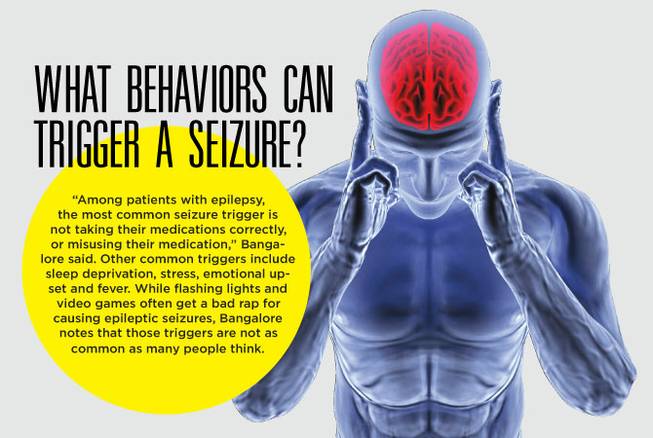
Monday, Aug. 15, 2016 | 2 a.m.
It’s estimated that 1 in 26 Americans has epilepsy or will develop the disease during his or her lifetime.
Epilepsy is a neurological disorder defined by recurrent and unprovoked seizures. Seizure frequency varies widely from person to person, with some experiencing many seizures per day while others go years at a time seizure free.
“Epilepsy can really affect a person’s quality of life, but oftentimes, it doesn’t have to. It can be managed, controlled and treated under the right circumstances,” said Samir Bangalore, MD, neurologist and epilepsy specialist at Sunrise Hospital and Medical Center. Highly personal and bearing many different variations, epilepsy is a perplexing condition for which proper diagnosis and effective treatment can be lifesaving.
What is an epileptic seizure?
A seizure occurs when there is a disturbance in the electrical activity of the brain. This electrical disturbance can occur throughout the entire brain (generalized epilepsy) or be limited to a designated area (focal epilepsy).
Some seizures can occur as a reaction to specific, identifiable stimuli — alcohol withdrawal, for instance — whereas epileptic seizures generally occur without provocation. “While many patients with epilepsy have certain things that may trigger a seizure, the probability that another seizure will occur is what qualifies it is as epilepsy,” Bangalore said.
He also notes that about 10 percent of people will have a seizure during their lifetime, but only 1 to 2 percent of people are diagnosed with epilepsy.
Triggers
“Among patients with epilepsy, the most common seizure trigger is not taking their medications correctly, or misusing their medication,” Bangalore said.
Other common triggers include sleep deprivation, stress, emotional upset and fever. While flashing lights and video games often get a bad rap for causing epileptic seizures, Bangalore notes that those triggers are not as common as many people think.
Causes
Epilepsy can be caused by genetic factors or acquired from damage to the brain such as neurological infections (like meningitis) or brain trauma (from head injury, stroke, etc.). For most patients, there is no clear cause of epilepsy and the disease can be acquired during any stage of life.
Children who are born with epilepsy may even “outgrow” the condition by the time they hit puberty. “Oftentimes, a child will outgrow epilepsy if their first seizure occurs before age 13. This is because their brains grow and change so much as they mature,” said Bangalore. Adolescents who have their first seizure after age 13 and older adults who develop seizures are more likely to have lifelong epilepsy, though the nature of their seizures may change and evolve as well.
Seizures vary from patient to patient
There are multiple kinds of seizures, and each patient with epilepsy has a different experience with varying levels of severity. “Seizures are highly stereotyped; they’re not always the dramatic, convulsive seizures we see on TV. Convulsive seizures are a common form of epileptic seizure but for many people, a seizure can also be a spell of sudden confusion,” Bangalore said.
The symptoms of the seizure depend on where in the brain it’s originating and what parts of the brain it’s affecting. Seizures also can cause nonpurposeful or childlike behaviors, loss of awareness or consciousness, heightened emotions, numb or tingling feelings within the body, or unusual sensory reactions.
Because seizures can look so different between patients, epilepsy can be difficult to diagnose. Merissa Iannuccilli was diagnosed with epilepsy in 2015 after years of being misdiagnosed because her nonconvulsive seizures came with subtle and difficult-to-describe sensations.
“It’s important when diagnosing epilepsy that you get the entire story of the seizure: what it felt like, how long it lasted, the event or trigger leading up to it, how it felt afterward, if it’s happened before or since, etc. If those things aren’t conclusive, there are clinical tests available to monitor the electrical activity in the brain,” Bangalore said.
Treatment
For many patients, epilepsy can be well managed with medication and small lifestyle changes such as avoiding known triggers. However, about one-third of patients have drug-resistant epilepsy, and for these people, surgery may be the next-best option.
The surgical procedure to address epilepsy removes the parts of the brain where the seizures are originating, and because of this, not all people with epilepsy are good candidates for surgery.
“The patient must have focal epilepsy and the electrical abnormality must be isolated to an area of the brain that does not control a vital function,” Bangalore said. Vital function refers to areas of the brain that control speech, movement and memory.
Once a patient is identified as a good candidate and decides to get the surgery, healing can take up to a few months, and the patient will continue to take epilepsy medication for a full year following the procedure. Even after a year, some patients will continue to need medication to help manage their epilepsy, but the majority are able to live both medication-free and seizure-free for the rest of their lives.
Iannuccilli, who received the surgery this year, has already seen its benefits. “For the first time in over a year and a half, I’m able to drive again. I’m not being woken up in the middle of the night by my seizures. I’m not afraid of when the next one will be. And those things are pretty amazing; my entire life has changed,” Iannuccilli said.

Join the Discussion:
Check this out for a full explanation of our conversion to the LiveFyre commenting system and instructions on how to sign up for an account.
Full comments policy